“Dang it.”, I thought. I could hear the squawk of magpies over the continuous rustle of aspens turning golden in the mountain breeze. The striking contrast of white and black iridescent beauty in their plumage was quickly eclipsed by their grisly reputation: dead animal eaters. Hearing the cacophony of chattering and clamoring magpie was not a pleasant sound to my rancher ear anywhere on our summer grass ranges, because where the carrion birds gathered there was usually death. My immediate concern pushed away the enjoyment of thick air that filled my senses with the fragrance of fall, instead it dominated my mind with this thought: another wolf kill.
As I broke through the white barked aspen trees astride my Morgan mare Missy into a broad meadowed opening on the banks of Little Hat Creek, I spotted the carcass, complete with a flock of magpies scrapping over their newfound bounty of beef.
It was October of 2007. We were running cattle in the 70 square mile piece of real estate that we simply called “Hat Creek.” It was a broken pile of canyons, creeks, mountains and goat-rocks. But scattered over it in a crazy quilt mosaic was some of the most diverse and nutrient dense wild forage on the planet.
We had turned out our 250 cow calf pairs and yearlings to the country back in May. It was now October, and I was “cow hunting.” It was time for the fall gather. The week before, Melanie (at that time, 13 years old), and Abby, 12, had found most of them on the other side of the range, about 12 miles away. But today, I was looking for the lost. The strays.
And I had found another one.
Missy blew nostrils clear and inhaled carefully with eyes focused and ears pricked as we approached the downed bovine; like I, she began to smell the early signs of decay wafting in the up-canyon breeze. I recognized the steer immediately; it was one of the belted Galloway cross beeves we had at that time. Their ‘Oreo-cookie’ black and white coat pattern clearly defined them from anyone else’s, as no-one else in this part of the Idaho mountains had that particular cross in their cow herds.
My heart sank as I rode closer. The yellow eartag absolutely confirmed the steer as ours. I hated losing cattle; although they are never a partner or companion like a horse or dog, I’ve lived with them in a husbandry relationship. I’ve raised them and cared for them, fed them in the winter, managed grass for them in the summer, always granted them clean water, rode endless days on horseback back to back with little to no sleep gathering them, guided them to safe haven from blizzards, subzero winter winds and summer heat.
I get to know them, and so, I mourn when I lose one. I hate losing them.
A special salt-of-the-earth ranching friend and neighbor of mine, Donna, once stood by me after I had to dispatch a broken-legged cow with a rifle. She saw me hating it, and she knew it was because that cow had been through it with us. She was one of the first we had, and had raised many fine calves on early Alderspring. She put her arm around me and simply said “I guess God decided that the wild critters gotta eat too.”
And she was right. They need to eat too, whether they were coyotes, cats, bears or wolves.
I dismounted, leaving Missy standing with reins up over her neck. She was one of the best ‘ground tying’ horses I’ve ever had, even to this day. You could leave her standing anywhere, and she simply stood where you left her, untied, alert and not grazing, waiting patiently for your return. I walked over to the body of ‘Beltie,’ (it’s what we often called our Galloway herd mates), and found that he died just recently—perhaps within a day or two. The flies had found him, as well as the magpies who started working through the thick hide. But no canines (wolves or coyotes) or even bears or mountain lions had yet found him, as his hide was largely intact.
It wasn’t if they would find him; it was when. When the fragrance of meat going south started wafting on the mountain breezes, all members from the top of the food chain took heed, already conditioned, even genetically by the Pavlov bell of decay scent. I looked up at the white bark aspen trunks around me. Certainly, the bears may be first on the scene, as they had already marked almost half the trees in the grove with claw marks—their graffiti tag of the mountain wilds.
Or could it be that lions would be first to the meal, as I had spotted large cat tracks in the mud just a quarter mile up canyon. Tracks nearly big as a young wolf, and generally similar in configuration, but the retracted claws was an unmistakable sign of big cat.
The thing that nagged at me was not as much who was going to eat Beltie as much as who or what killed him. We had been losing an occasional cow to predation by the roving 12 member Morgan Creek Wolf Pack. They would dive down into our country from the high, snowdrifted alpine ridge that defined the boundary between Hat Creek and Morgan Creek watersheds. I had been up there along those snowdrifts and seen the deep trail worn into the icy snow, packed down like a highway. It was clear that the pack would repeatedly use this conduit while doing a scent recon mission of the two opposing drainages.
First, they would wind the prey. Their noses were incredibly fine tuned—perhaps among the best in the animal kingdom. Then, they would recon by sight. They would find a lone steer, heifer, or even mama cow and calf, surround them, and pounce. Two or three would create diversion and nuisance in front of the animal, not really attempting to connect, but obviously stealing all the prey animal’s attention. Then, large alpha-sized canines from the rear would reach in and hamstring the animal, debilitating them and then, it was simply a matter of time as more and more wolves would take the bovine down. Massive jaws turned muscle, sinew and even bone into hamburger.
But there were no chew marks as of yet on this steer. There was no evidence of emaciation or disease. The only thing I picked up was a little foamed saliva at the mouth.
It was necessary detective work to uncover the mystery. This, too, was husbandry. I owed it to the live ones to find out.
The saliva bothered me. It wasn’t necessarily a tip, but I had a suspicion. Sometimes animals with excess have an issue in their GI tract. In this case, however, I was thinking poison.
I commenced to trace down the culprit. I knew my plants fairly well thanks a degree in forestry, but even moreso to my decades-long marriage to a PhD botanist. The trick was to find remains of a specimen, partly eaten—complete with telltale bovine tracks and droppings proximal to the offending vegetation. I began a slow spiral of concentric circles from Beltie.
It wasn’t a long search. Most of the vegetation had been found first by elk, then by cows. And because it was green and well-watered by the creek that murmured nearby along some willows, in this autumnal time of year, areas like this were grazed more extensively than their surrounding sagebrush uplands. I couldn’t exactly blame the cows. Green vegetation established alongside creeks was much more fun to eat than the dry and brittle bunchgrasses on the hillsides.
So they ate it all. And when they had eaten what they liked, the cows began to work on things they didn’t like.
I continued my spiraling walk, and after only arriving in the 5th orbit in the Beltie solar system, I found what I was looking for. A cluster of green and robust hollow plant stems over 3 feet tall got my attention. They were clipped off and missing. Large, maple-like dissected leaves shot out from the base of the remaining stem. But the floral head—actually, now, the seed heads, were completely gone.
Eaten. By my cow. Correction: cows. More than Beltie had grazed here, but others got away with their lives. I recognized the plant immediately: tall larkspur, or great Delphinium.
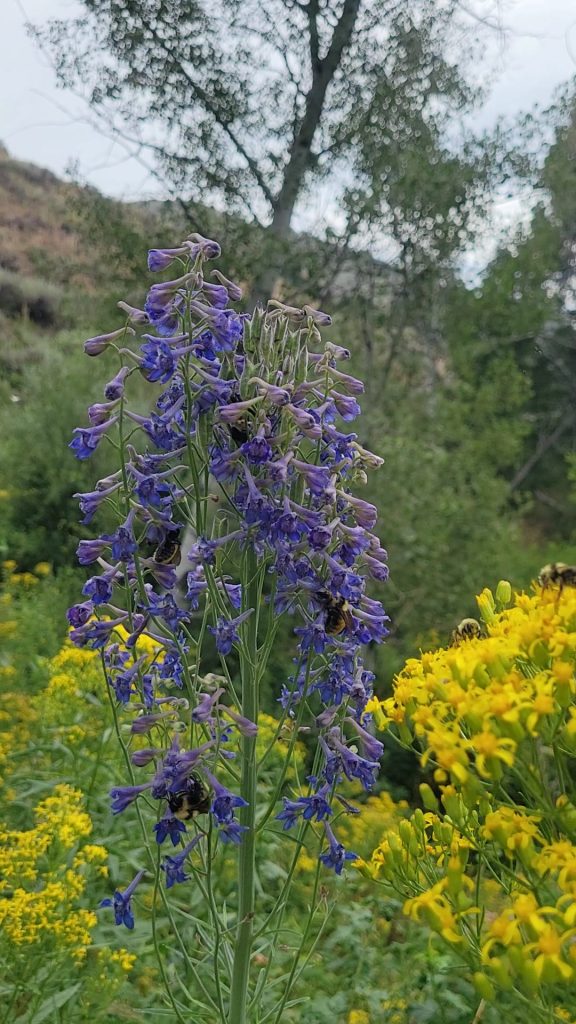
Indeed, larkspur is poisonous to livestock when consumed in quantities. In our earlier years of ranching, we’ve lost cattle several times to ingestion of the plant. In fact, ranchers through much of the West simply call the plant “poison.” It’s why there is a Poison Creek in nearly every county in the Intermountain West. Livestock operators simply called it for what it was When there were large quantities of larkspur in a given draw, creek or canyon, the name often stuck—especially when each year, operators lost cattle up there from consuming the plant.
It’s an incredibly beautiful native plant (domestic flower gardeners love it too). This year, 2022, was an exceptional year for the plant, and some specimens I found while riding horseback up there this summer were up to my chest—while mounted! The deep purple flowers adorn mid to high elevation meadows where there is sub surface water; they often share habitats with aspen and willows. In addition, the meadow grasses are lush and green and deep.
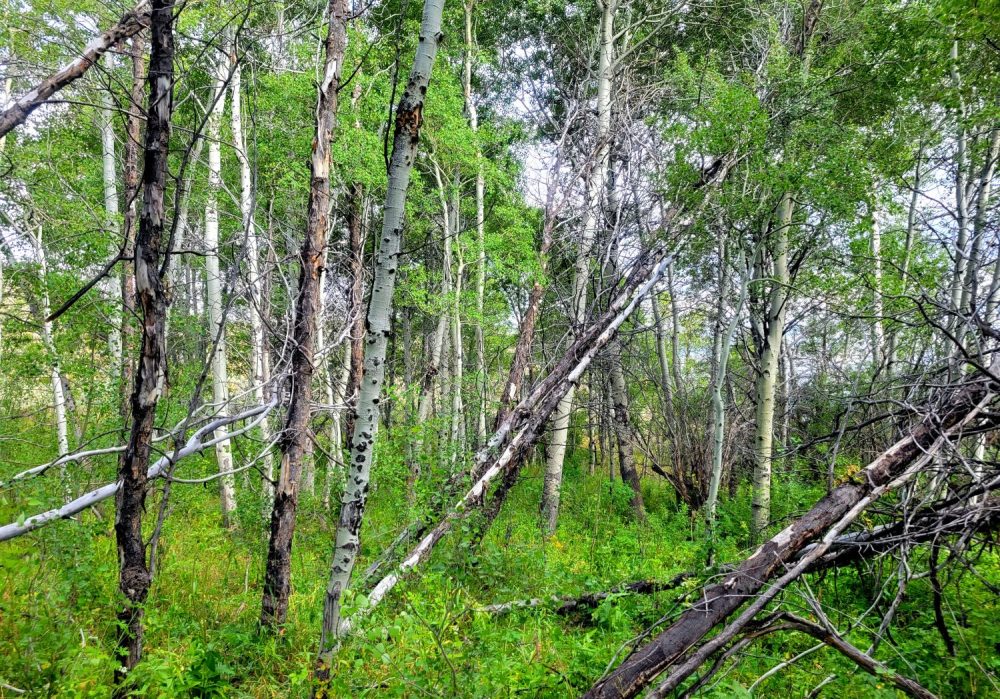
Where larkspur likes it, all of the wild grazers like it. Where larkspur’s lovely blooms festoon meadows, you are almost certainly going to find elk—or at least their beds. We have often jumped entire herds of the majestic antlered animals as they explode from their grazing and resting honey hole in the tall grasses and flowers that also happen to harbor lots of larkspur.
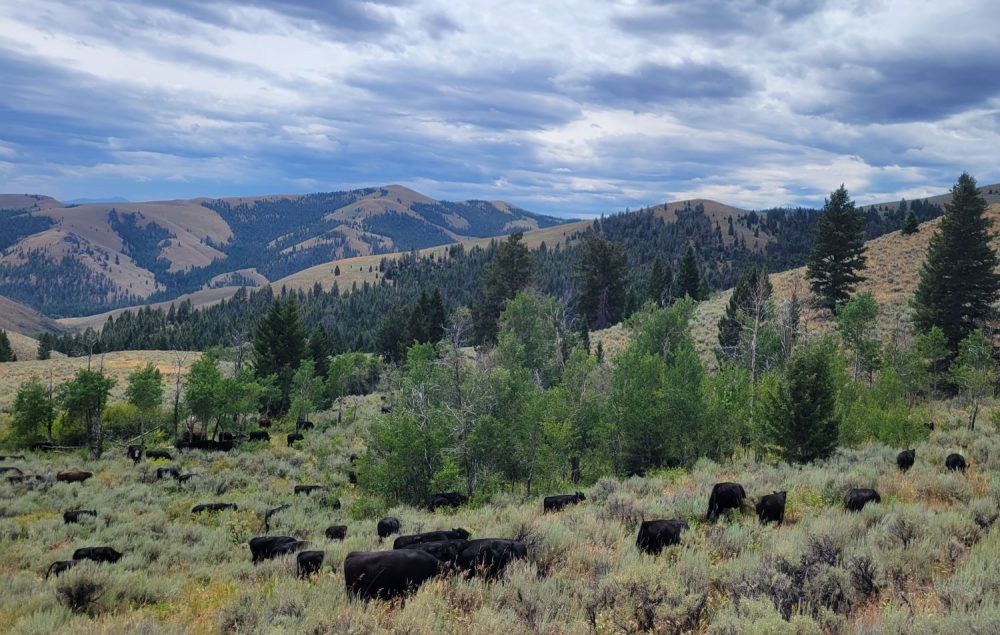
Larkspur is not a weed, although there was a time when even government officials attempted to eradicate it from the public lands of the West with chemicals. The plant was the cause for thousands of head in lost livestock every summer. The threat is still real, although it’s been awhile since I’ve heard of government sponsored herbicide campaigns for larkspur.
Just 5 years ago, I heard of a rancher in the next valley from near the town of Mackay who lost over 45 head of cows to larkspur in one afternoon. The plant could indeed mean spell the disastrous demise of anyone’s cattle. We used to pay a lot of attention to areas rich in larkspur. We would hurry the herd through on horseback, and make mental note of that spot, so as to herd cattle away from there.
I’m guessing that big game is also susceptible to the toxins in larkspur, but I have yet to see an elk or deer dead near a larkspur stand. I often wondered why.
And now, after 9 seasons without a single bovine death from larkspur, at long last, I’m thinking I might be piecing together the puzzle.
As I said, this year, the year 2022, was a great year for larkspur. I’d often see the tall flowering stalk rise over 6 feet in alpine meadows. Seedpod and seed production was prolific. The broad flowering heads often would have a cluster of 5 massive native bumblebees on it (apparently immune to the toxins). Our cattle would pick their way through meadows thick with tall native grasses, Senecio (we often mistakenly call it goldenrod because of it’s similarity to it), and hundreds of other native plants including the great Delphinium.
In one particular meadow this summer, Linnaea, Brittany, Josh and I let the cattle spread out over a beautiful basin below Iron Mountain. Last year, we had a pack of wolves living in and around the meadow for part of the summer, and we weren’t as lax as we were this year. But we had no sign of the ‘big dogs,’ and we had our own border collies as alarm bells if the big ones came, and we humans spread out a wide perimeter over about a 200 acre piece of aspen glade and thick meadow for about 3 hours.
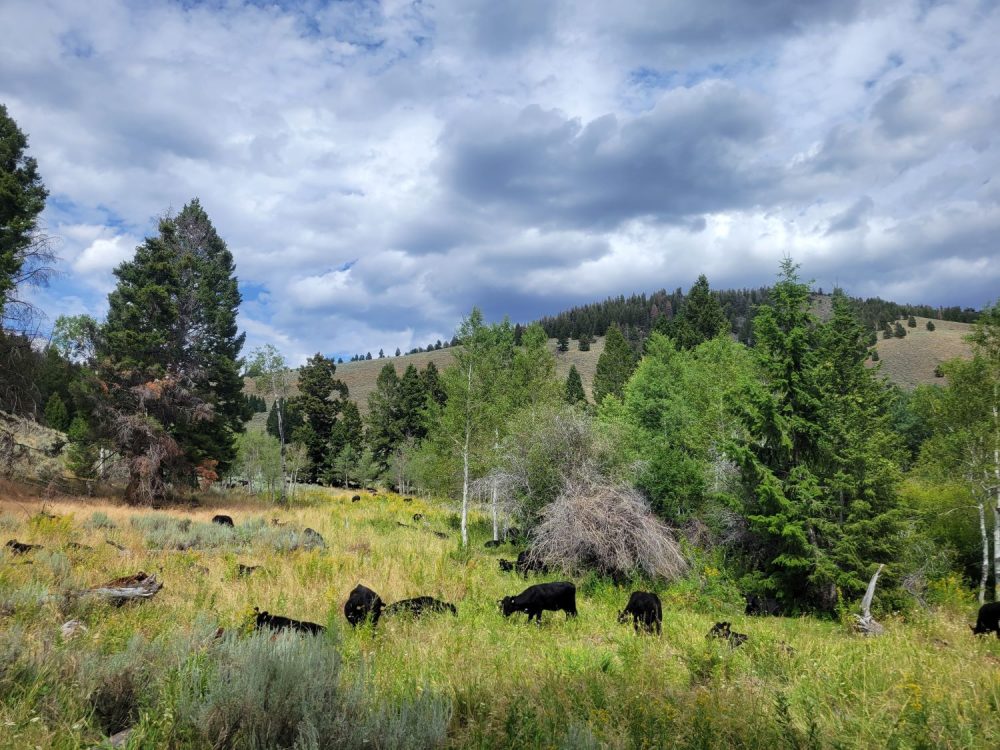
The beeves loved it. Over 400 head spread out and just grazed with abandon, as we grazed from our saddlebags and caught much-needed siestas in the shade of the trembling foliage of the aspen trees.
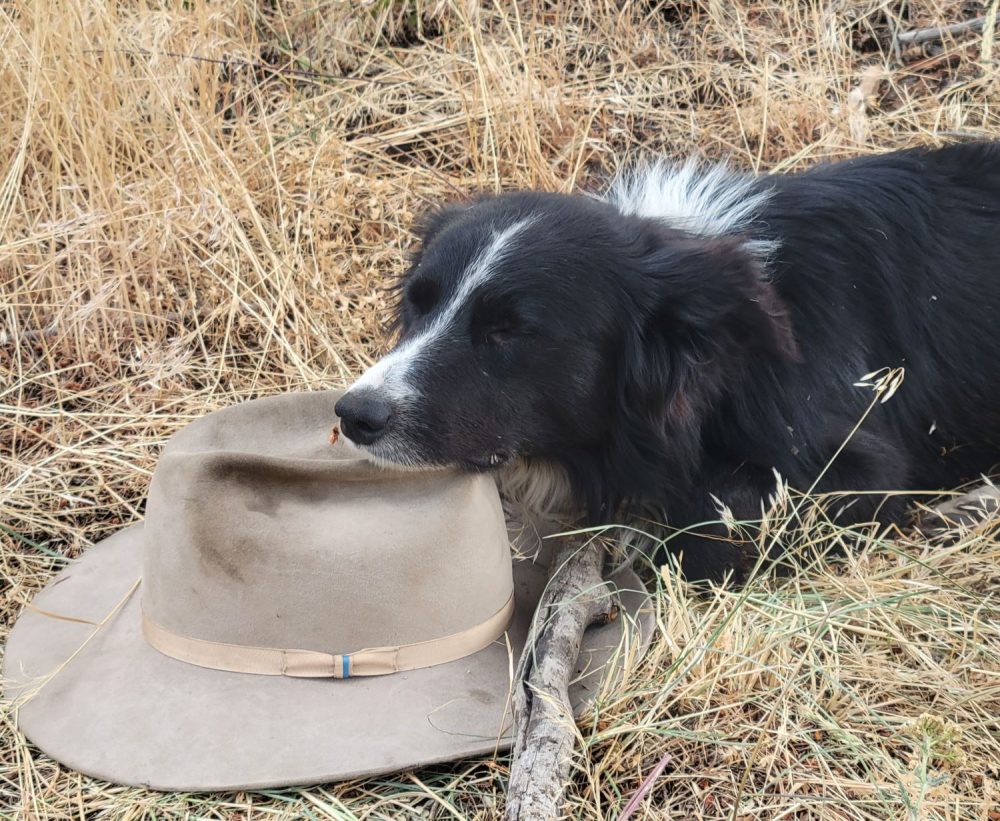
During that break, the ‘why’ question came to mind once again about larkspur. I hadn’t noticed any of our beeves grazing it, yet it was lush, inviting, green, and tender and huge.
It would be really easy to eat.
So I went out there and begin a random foray across those acres. First, I broke some stems and leaves. Was there an obvious off-putting scent? Did it smell like poison? Negative on both counts. Then, I carefully inspected every plant I could find. All around them (there were hundreds), our cattle were happily grazing. Some were laying in the shade. All seemed to be very content in the larkspur meadows.
Upon close inspection of literally hundreds of plants, I could not find one that had a bite out of it. Yet, all around each plant, nearly every other plant had some indication of light grazing.
Why didn’t they eat the larkspur? And why did our cattle used to eat it, but don’t any more?
First ventured and educated through observational guess: I don’t think they like larkspur. At all. I didn’t even see them sampling it, yet, they one hundred percent knew that it was not a good thing to graze. So they left it alone. Perhaps they could smell a toxic alkaloid that I couldn’t. Perhaps there’s a genetic code marker in bovines that recognizes that plant and says “do NOT eat that.”
Or perhaps, as our friend from Bozeman said a couple of weeks ago when we talked about the same thing regarding another plant and why cattle don’t graze it, “God told them.”
I don’t know.
But I do know that they don’t eat it. Unless.
They have to.
Every time I have see larkspur eaten in meadows by cattle, everything else is gone. To the dirt. And to the demise of everything else that lives there. All the palatables are eaten. There’s just woody plants left, and larkspur.
So cow, creature of habit that she is, doesn’t want to leave the wet meadow. She has good short term memories here. There is no more top of the food chain predators that will hide and hunt them here (they have been for the most part extirpated by stockmen hunters a hundred years ago); and climbing up that hill to eat that dried out bunchgrass looks like a lot of work to a 1250 pound cow.
So, she opts for a bite. And after finding it fairly tender and edible, she takes another. And pretty soon, within 7 to 24 hours, the toxins take effect. Alkaloids slowly cause muscle coordination to fail and death often follows shortly thereafter.
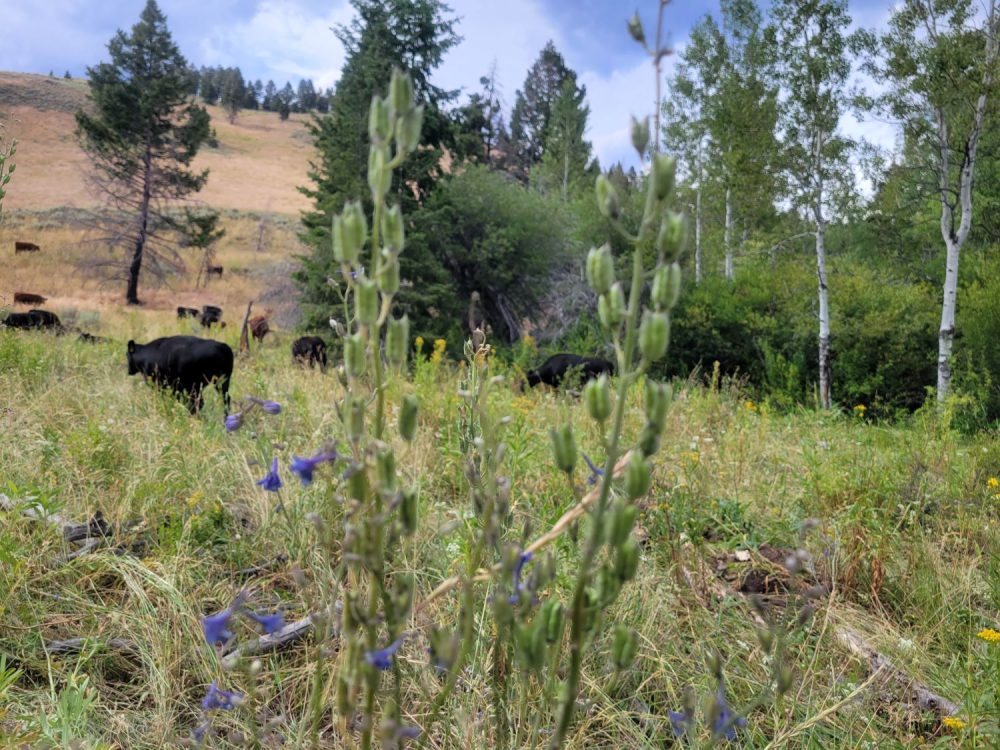
We’ve never seen elk or deer stay in overgrazed creek bottoms. They simply move on to where they will find adequate food.
But cows will follow the two ‘Gs’, as we call them. The siren song of green and gravity are irresistible, and the large modern bovines will follow those predictably to a canyon, creek or river bottom. Their ancient ancestors were trained by predators to stay away from creeks, canyons and brush bottoms, as ambush by a toothy carnivore made them an easy meal.
But today’s ranch cow rarely worries about such things. Grizzlies are for the most part extinct from the western ranges. Wolves are infrequent visitors to most of the western grazing lands.
But predators were once prolific inhabitants, and when grazing herds grew, the predator population grew with them. And so the training of bison, elk, moose and deer and other users of creek bottoms was incessant. And creeks weren’t overgrazed.
And grazing of larkspur didn’t happen.
What made the change on our ranges? Thank that top of the food chain. In 2014 we lost more cattle that we could bear to wolves. In retrospect, Caryl and I are realizing that the wolves taught us a lesson: no longer could we just send our cattle out there without management.
We had to go with them.
Now, with our completely different take of management of our herd with what we coined as “inherding” our cattle are always moving, like the wild herds did before settlement. We now live with our cattle in remote cow camps for the entire summer, and keep them all in an intact herd, emulating the wild buffalo that ranged in these mountain grasslands before us. Instead of predators always keeping ungulates on the move, we do, on horseback. It means that our cattle gain weight better, and creeks regenerate successfully.
And the wolves no longer enjoy our beef—because of our non-confrontational human presence. But there is much more: aspens are returning, willows are colonizing and beavers bounce back. Songbirds make nests, and fish spawn in clean waters. Larkspur is ungrazed (I think those bumblebees are grateful!) And our cattle no longer perish because of it.
All because we keep them moving.
Happy trails to you all.
Glenn

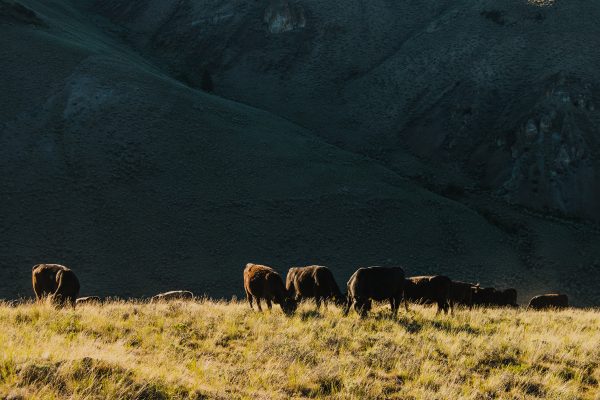


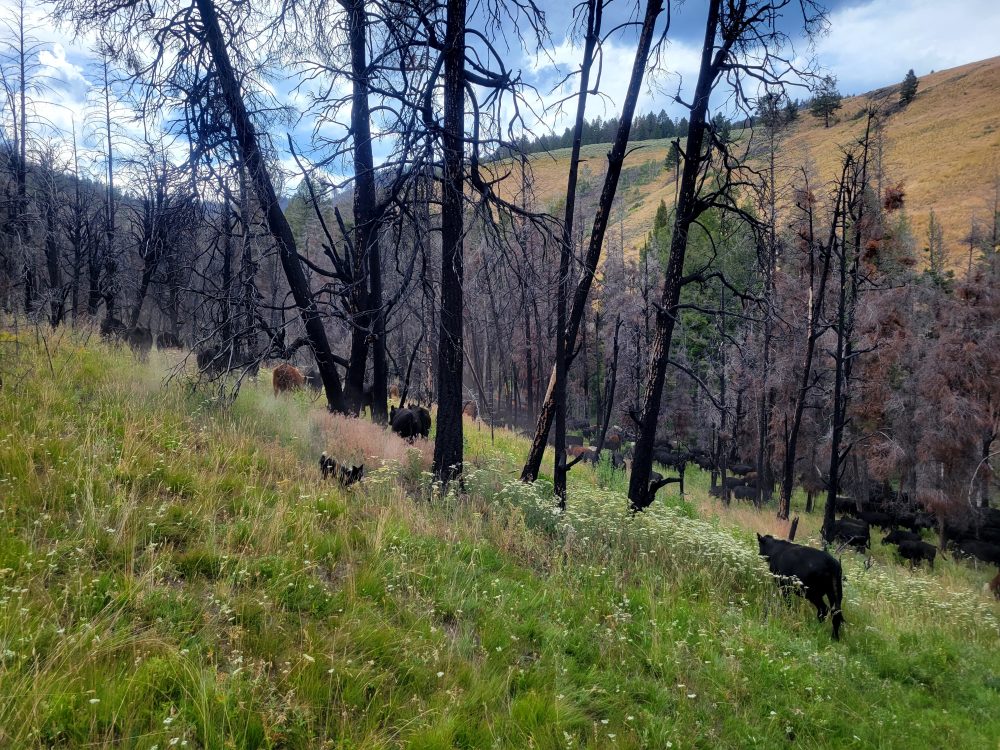

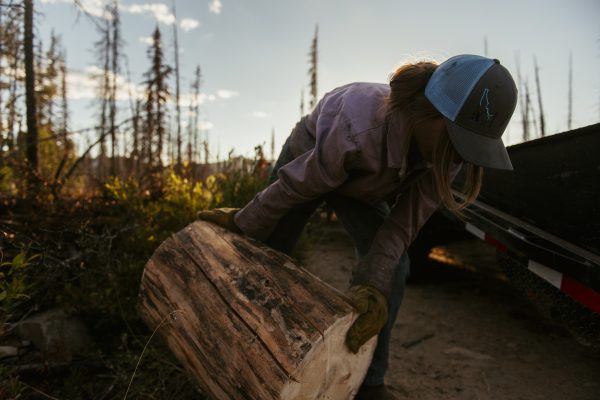
Vicki
Beautiful as always…so well written and it all comes to life..sorry for the larkspur
death. Thank you for your grand work and great sharing of
amazing stories.
Vicki
David Such
Nice story – educational and well-written. I never knew that about Larkspur, but now I do. Thank you.
Caryl Elzinga
David
Thanks for your kind words. It took us awhile to figure it out, unfortunately. We lost a few in the process. But it stuck in my mind that the elk and deer don’t die from it. That got me thinking…
-Glenn
Mike
Interesting article. I’ve seen some Loco Weed here in Texas and worrisome mushrooms too. The Mesquite tree beans can be toxic to cattle; again only if a drought coupled with poor pastures causes over consumption.
Now by camping off-grid 24/7 I am closer to nature and in the ‘green space’ my health has improved greatly even for a senior.
Caryl Elzinga
Mike
You nailed it with the drought. Stuff is almost always more toxic with it, even camas and locoweed. We have cattle right now on some sudangrass, and we have to watch it to get it through drying and frost as water stress will make it toxic. Interesting stuff. Every second I think I am figuring out the graze, I find out that I know very little!
-Glenn